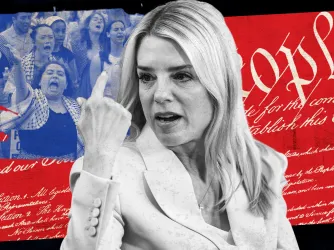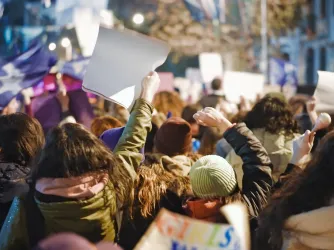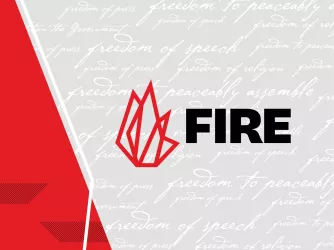Table of Contents
Even Affirmative Consent Advocates Seem Confused About Affirmative Consent

FIRE and many others continue to criticize the vague requirements of California’s new law requiring the state’s university and college students to obtain verifiable, ongoing “affirmative consent” for sexual activity. Among other problems, supporters have not clearly explained just how often one must explicitly ask for permission in order for consent to be considered “ongoing.”
On a KPBS Radio segment on the issue earlier this week (and featuring my colleague Joe Cohn), host Tom Fudge asked victims’ attorney Jessica Pride whether the bill “mean[s] that a person has to ask not one, but many questions? Now may I touch your breasts, now may I take off your clothes … .” In response, Pride called that interpretation “silly.”
It’s evident that not all advocates for the law agree, though. UltraViolet, which describes itself as a “new and rapidly growing community of women and men across the U.S. mobilized to fight sexism and expand women’s rights,” recently released a video called “Consent Porn” that they say “perfectly illustrates how [affirmative consent] works.” It features two couples—a pizza delivery guy and a female student, and two men in a laundromat. In the first vignette, Pizza Guy indeed stops mid-kiss to ask the female student if it’s okay for him to touch her clothed hip. This would appear to conflict with Pride’s interpretation of the law as not requiring such questions.
In the second vignette, after one laundromat fellow (let’s call him “Serious”) asks the other (let’s call him “Smiley”) if he can kiss him, both lean in and open their mouths at the same time. Then Smiley stops and playfully mocks Serious, implying that he didn’t say “yes” yet. And indeed, he didn’t verbally say yes, but one could reasonably determine that he had expressed yes by leaning in with his mouth open and his head tilted. (He does verbally say yes a few seconds later.) Viewed in the context of the repeated reassurances offered by affirmative consent advocates that spoken consent is unnecessary—the bill was even amended to remove a statement that nonverbal cues might not be adequate—the law’s application to this interaction is uncertain. Was Serious about to commit sexual assault? It’s not at all clear.
Another interaction depicted in the video is similarly confusing. After Pizza Guy expresses regret at apparently having brought the pizza to the wrong room, Student is so overcome with emotion at his consideration that she grabs him by the shoulders and kisses him. Only then does she ask, “Is this okay?” But under California’s new law, she’s already committed sexual assault. She is unambiguously the initiator of this contact. She did not obtain consent before kissing him. He didn’t have time to resist or to protest, but of course, even if he did, the law states unequivocally that “[l]ack of protest or resistance does not mean consent.”
By the same standard, Smiley assaults Serious in the video, too. They consent to kissing, but after a few seconds Smiley removes Serious’s shirt and pushes him back against the dryers, touching his head, neck, and chest. He didn’t ask permission to do any of those things. Consenting to kissing does not mean that you have consented to being disrobed by your partner; per the law, consent has to be ongoing.
If supporters of the affirmative consent standard can’t agree about what’s required under the law, and the purported “perfect” illustration of consent in fact depicts what is plainly not consent under the law, how can supporters still argue that the affirmative consent standard will be easily understood by students and fairly administered by universities?
As Jonathan Chait observes today in New York Magazine, some supporters of California’s new law don’t seem to be concerned about the law’s impracticability:
Indeed, the law’s advocates don’t uniformly believe its written standards will actually be followed at all. This defense by Amanda Marcotte is telling: “The law has no bearing on the vast majority of sexual encounters. It only applies when a student files a sexual assault complaint.” So the law will not come into play because nobody will actually try to enforce it. Instead, it will technically deem a large proportion of sexual encounters to be rape, but prosecutors will only enforce it if there is an accusation. And since most, and possibly nearly all, sexual encounters will legally be rape, then accusation will almost automatically result in conviction.
Indeed, this may be the point. [Tara] Culp-Ressler dismisses concerns about convictions of innocent people. (“In reality, false rape allegations are very rare, comprising about two to eight percent of all reports.”) Two to 8 percent seems like a fairly high number of innocent people to convict as rapists, and of course that proportion could well rise quite a bit under a legal regime that expands the definition of rape in ways that are both extremely broad and extremely confusing.
Extremely broad and confusing indeed.
Recent Articles
Get the latest free speech news and analysis from FIRE.

Trump’s New York Times lawsuit is a call to action for the ‘paper of record’

Why everything Pam Bondi said about ‘hate speech’ is wrong

Why RICO can’t be used to punish speech
